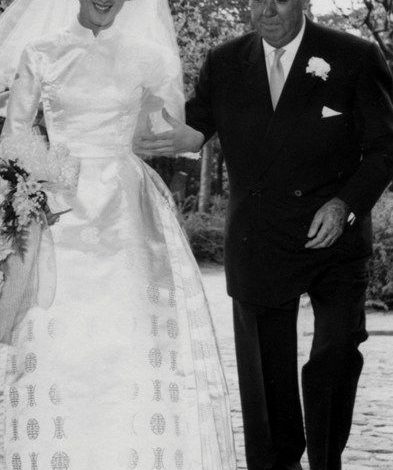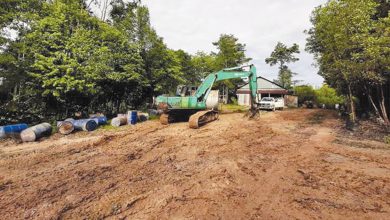Ruth’s Labour of Love


By Mariam Mokhtar
In 2009, Ruth Iversen Rollitt, the daughter of one of Malaya’s most distinguished architects, Berthel Michael Iversen, was in Ipoh attending a ‘brainstorming meeting’ organised by the then chairman of the Perak Heritage Society, Law Siak Hong. Amazed at the rich legacy left by Iversen, publisher Khoo Salma Nasution of ARECA books, who was also present, told Ruth, “I would like to publish a book about Iversen!”
Five years later, after many trips to Malaysia, working with Salma and her team in Penang, and correspondence via the internet, Ruth’s labour of love, called Iversen: Architect of Ipoh and Modern Malaya will be launched, in March at four locations, Penang, Ipoh, Kuala Lumpur and London.
The 230-page book, is a pictorial feast of both black and white, and coloured photographs, from the albums which Ruth’s mother compiled for her father. Ruth said, “It had taken at least three years to publish and contains excerpts from my father’s letters to his mother and also pages from his book, called Unfinished.”
When asked if there had been difficulties with writing the book, she said, “Only impatience from my side.”
Accuracy was important and Salma’s team liased with other architects and members of the public, who had knowledge of Iversen’s buildings. Ruth expressed her gratitude and said she was lucky to have kind people “interested enough to help me”. “We got there in the end!” she added with relief.
The young Iversen loved drawing and enrolled at the Royal Academy in Copenhagen, to study architecture. In 1928, his older brother, Werner, who was a planter in Malaya, enticed Iversen to join him in the Far East.
Eight years later, having established his own firm, ‘Iversen, van Smitteren & Partners’, Iversen built government buildings, hospitals, schools, radio stations, churches and private homes, both in Malaya and Singapore. It was said that to own an Iversen home, showed that one had made one’s way in the world.
Iversen supervised the building of many famous landmarks like the Chinese Assembly Hall in Kuala Lumpur, the grandstand at the Ipoh race course, the Capital Cinema in Singapore, and the Grand Hotel, Mercantile Bank and the Lam Looking Bazaar in Ipoh.
His firm was responsible for many buildings, including the Ipoh Swimming Club, the MCA building, the Lido cinema and the Geological Survey building in Ipoh. In Kuala Lumpur, the Loke Yew building is an Iversen creation whilst in Penang, he built the Chinese Swimming Club and many private homes.
Malaysians are only too aware that in towns and cities, greedy landlords, ignorant town planners and unscrupulous officials and developers have earmarked land, with many buildings, of important heritage and historical value. The buildings are bulldozed, to make way for more lucrative projects. Ipoh is not spared.
Ruth once expressed alarm that many Iversen buildings have been destroyed. She said, “Cinemas are being demolished. Houses pulled down. They are not big and pompous enough for the present generation. Developers can fill the sites with many smaller homes or ghastly condominiums, and make money!”
Iversen spent 40 years in Malaya, apart from during World War II. After the war, he returned to help rebuild the country. One social observer commented that Iversen “formed the building blocks of the newly emergent nation.”
“Fortunately, many of his buildings are still around, and the people who talk about him do so with respect and fondness,” adds Ruth.
On a visit to the National Archives in KL, Ruth was surprised to discover that Iversen was “unknown”. In 2012, she expressed regret that she had been unsuccessful in persuading Ipoh’s town planners to find old plans, and confirm which buildings had been recognised as Iversen’s.
Ruth, who was born in Batu Gajah, remembers that as a little girl, her father would take her for a spin, in their Humber Super Snipe, and as they drove around town looking at his buildings, give her architecture lessons. She said, “It was my joy and pleasure to learn from him. He cultivated my interest and love for good architecture and construction.”
On his retirement in 1966, Iversen hired a car and drove around Malaysia, to bid farewell to his “adopted” country.
Iversen’s rich treasure of letters and thousands of photographs chronicling his work in Malaya, are preserved at the Royal Library in Copenhagen. His work and that of other contemporary architects, in Malaya, is of immense social, architectural and historical importance.
In 1954, the British High Commissioner Donald MacGillvray, officially opened an Iversen prize-winning design, the Federal House, in Kuala Lumpur. Federal House had originally been destined to become the Post Office Savings bank.
Sixty years later, another British High Commissioner to Malaysia, Victoria Treadell née Jantz, who like Ruth, was brought up in Ipoh, will host the KL launch of Ruth’s book, Iversen: Architect of Ipoh and Modern Malaya .
Ruth said, “That is wonderful! Vicki’s the little girl I have known for so long, who will honour my father!”
When asked what his reaction would be, if her father were alive today, she said, “He would be so happy and proud of me. I love him so much and I have felt that he has been standing behind me all the time and told me: ‘Thank you’!”
“The book is dedicated to his five grandchildren – he was the world’s best father and grandfather!”


